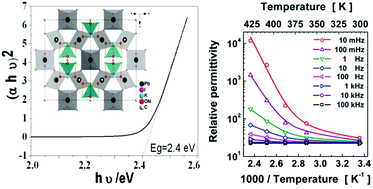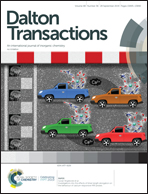Synthesis and investigation into the structural, electronic and electrical properties of K2Pb(OCN)I3†
Abstract
Yellow transparent single crystals of the new compound K2Pb(OCN)I3 were synthesized from a mixture of lead iodide and potassium cyanate through a solid-state reaction, which was controlled by the differential scanning calorimetry (DSC) technique. The single crystal X-ray refinement showed that K2Pb(OCN)I3 crystallizes in the cubic system (Fd![[3 with combining macron]](https://www.rsc.org/images/entities/char_0033_0304.gif) m, a = 16.295(2) Å, V = 4327(1) Å3, Z = 16 and R1 = 0.0167). The structure is basically composed of two frameworks built from potassium tetrahedra capped by OCN− units and corner-sharing lead iodide octahedra. The infrared spectrum of K2Pb(OCN)I3 reveals the presence of vibration modes that were assigned to cyanate ions. The band structure and total and partial density of states calculated by DFT with the PBE functional (CASTEP code) showed that this compound exhibits a direct band gap of 2.19 eV, which is in good agreement with the experimental value obtained from a diffuse reflectance measurement (2.4 eV). The investigation of the electrical properties of this material demonstrates that it is highly resistive and has large permittivity (relative values of up to 104 at 150 °C). However, it does not display ferroelectric behavior.
m, a = 16.295(2) Å, V = 4327(1) Å3, Z = 16 and R1 = 0.0167). The structure is basically composed of two frameworks built from potassium tetrahedra capped by OCN− units and corner-sharing lead iodide octahedra. The infrared spectrum of K2Pb(OCN)I3 reveals the presence of vibration modes that were assigned to cyanate ions. The band structure and total and partial density of states calculated by DFT with the PBE functional (CASTEP code) showed that this compound exhibits a direct band gap of 2.19 eV, which is in good agreement with the experimental value obtained from a diffuse reflectance measurement (2.4 eV). The investigation of the electrical properties of this material demonstrates that it is highly resistive and has large permittivity (relative values of up to 104 at 150 °C). However, it does not display ferroelectric behavior.



 Please wait while we load your content...
Please wait while we load your content...